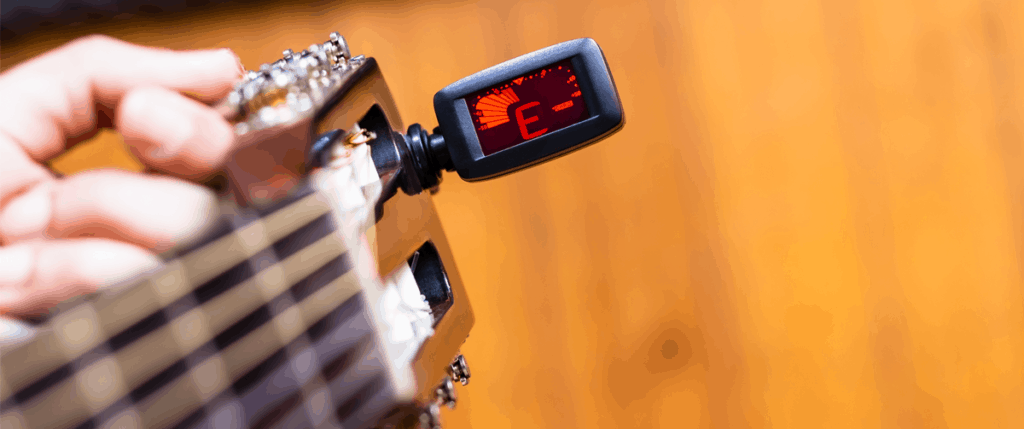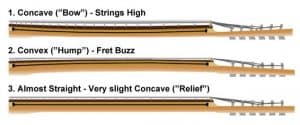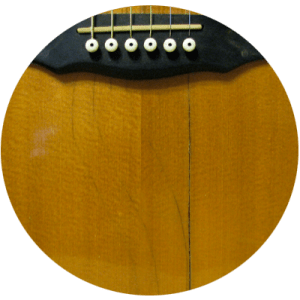
Why is my guitar playing out of tune?
Are you out of tune between frets 1 and 5 or up around the 12th fret and higher?
This is a common problem and quite honestly a miss understanding of what is supposed to occur and is relatively easy to correct.
Over the years I have had many players and real good quality Instructors who have said:
“you know it’s a fact of playing guitar that my guitar is out of tune.”
“its all right further up the neck but close to the nut I just have to tune the guitar a bit flat and its all good.”
While there are tons of work arounds, it is much simpler to deal with the root cause of why this is happening in the first place.
There can be several different factors that are influencing why the guitar is playing out of tune.
– How old are your strings? Are they at their end of life?
– Does your truss rod need an adjustment?
– What’s the string height at the nut?
– Is my guitar in tune when I play each note open yet anything from frets 1 – 5 are playing sharp?
– Is everything ok however when I am playing higher than the 12th fret its out of tune.
Some of the above indicators are quite easy to fix for the player. Others might need the intervention of a good guitar tech or luthier.
Either way a thorough evaluation of the guitar will determine where the issue comes from and can be easily addressed.
Hydration of Guitars:
I always suggest at the outset to anyone who will listen, before you do anything get into a good hydration practice with all your instruments.
Let’s face it, whether it be electric or acoustic guitars they are all made out of wood, and wood will expand and contract with different humidity levels.
We can adjust anything however if you don’t have a good humidification program for your instruments the length of time that the adjustments stay diminishes.
I wrote an article about this which you can read here… (Click Here for Hydration Tips)
String Life Span, String Height and Truss Rod Adjustments:
Now that you know your guitar is properly watered 
We will ignore in this article the impact that high frets will have on this whole issue…
That’s a whole other conversation.
String Height:
Are my strings set at an optimal playing height and how’s my truss rod looking?
While string height is pretty well a player’s preference, there are limits to how low and how high you can optimally set them before they start messing with tuning.
To low and you get the joy of fret buzz. To high and as you must press harder on the strings you end up bending the string sharp all along the neck.
Every guitar manufacturer usually has a set of specifications on how they originally set up their instruments.
There is however a commonly used range as noted in this article by StringJoy.com.
Guitar Action: The Complete Guide to String Height & Action Adjustments
“For electric guitars, in our opinion, a good default string height at the 12th fret is typically about 6/64th of an inch (2.38mm) on the bass side and 4/64th of an inch (1.59mm) on the treble side.
For acoustic guitars, our recommendation bumps up to 7/64th of an inch (2.78mm) on the bass side and 5/64th of an inch (1.98mm) on the treble side.”
These are a good rule of thumb, and I encourage you to read their full article as it covers a lot of good to know information.
Truss Rod:
Your truss rod can affect your tuning again if we have to much relief in the neck.
Relief is basically the bow in the guitar neck which every guitar needs.

How much depends on a whole lot of factors. Typically depending on the guitar and neck layout you are between .006 – .012 of an inch at the 8th fret.
Electrics with a level fretboard can get pretty close depending on the rest of the guitar to the .006 level while acoustics on the other hand are in the .010 to .012 range due to the design of the strings.
If your truss rod is set to a higher or greater bow then what occurs is your strings raise higher. This causes the player to have to press more creating a sharp note.
You may be asking at this stage, well if it is set properly what can cause it to change?
This is great question as several different factors will affect it.
Change in humidity levels caused by seasonal change and or location of where you are playing.
Strings being at their end of life span will cause this, changes in String Gauge being used on the guitar.
Different tunings ie having your guitar set to E standard and then attempting to play in say C standard.
Any of these will cause tuning issues to arise.
String Life Span:
Every string manufacturer designs their strings to have a specific set of tensile strengths.
You may think, hey as long as I stay with the same gauge range of strings I am good to go..
That’s not always the case..
Each manufacturer has their own idea and designs on what tensile strength for their strings.
Why is this important and how does this affect things over time?
As strings age, they all lose their original tensile strength. This over times starts to affect the stability of the string in terms of staying in tune.
On top of this, as you have set the truss rod to the optimally relief or “bow” based on these original strings, you loose relief ending up with a neck that is flatter, and the strings end up being closer to the fret board.
All of the above creates a cascading set of circumstances that will completely mess with the guitars ability to be in tune.
String Height at the Nut:
So what’s the big deal about the Nut..
Surprisingly issues with a poorly fashioned nut has significant impact on your intonation.
While this is a much larger topic, if you are having notes playing sharp between your first 5 frets it is usually an indication of the nut slots being too high.
On top of making it hard to play what my good friend and guitar instructor Rick Fysh of Redguitar.ca calls “cowboy chords” and the dreaded F major bar chord, if your having to push down hard in these areas you are in fact bending the string beyond what is should be set to and thus having out to tune notes.
Probably the easiest chord to check and the most noticeable in my opinion if the D major chord.
If one of the notes is playing sharp it stands out significantly.
This is not something that anyone needs to live with, tune flat to compensate for etc….
12th Fret Intonation:
Your guitar is perfectly in tune from open though to the 11th fret.
Then you hit the dreaded 12th fret and BAM! The silly thing goes out of tune.
If your dealing with an electric guitar the fix is relatively simple to a little more complex depending on the style of the bridge…
On an acoustic, depending on how severe it’s a pretty quick alteration to a more intensive one.
Electric guitars:
Ignoring the differences in bridge types, as that’s a much larger topic, correcting intonation problems for electric guitars at the 12th fret is a simple as ensuring you have the string tuned correctly while playing the “open” note or unfretted note, and then checking to see if the note is still in tune when you play it at the 12th fret.
If it isn’t, then adjust the screw on the bridge, if the note if flat you need to bring the saddle closer to the nut, if its sharp, then you need to move the saddle further away from the nut.
A caution, depending on the tension on the saddles it is a good practice to detune, adjust the saddle, retune and check again. You don’t want to strip your adjusting screws….
Acoustic guitars:
This is a bit trickier as most acoustics do not have an adjustable bridge.
Thankfully most acoustics do not have an issue with 12th fret intonation as the bridge is put in the optimal place when its being built.
Subtle adjustments can be done by means of replacing the saddle itself and using a compensated saddle if there are subtle intonation issues.
If there are drastic issues then a more invasive repair needs to be done, involving removing the and relocating the bridge.
Thankfully, these are very few and far between…
As you can see, there are a lot of factors that could be causing why is my guitar playing out of tune.
The good news is that with a thorough analysis of your instrument it can be easily addressed giving you back your instrument that not only is much easier to play, but also allows you to play completely in tune anywhere on the neck.

